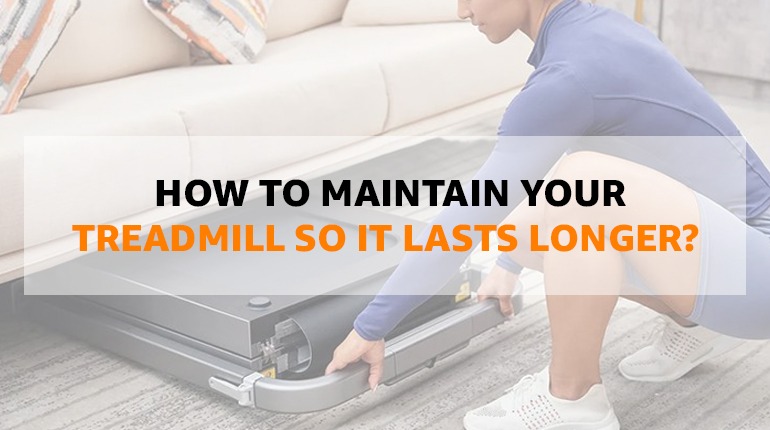How to Maintain your Treadmill so it lasts longer?

So, you bought that treadmill you always wanted, but now you’re staring at it, wondering how to keep it in top-notch condition. Don’t worry; we’re here to guide you through the journey on how to maintain your treadmill.
A treadmill is your gateway to better health and fitness. It’s the faithful companion that helps you shed those extra pounds, boosts your endurance, or simply provides a convenient way to stay active at home. But like any companion, it needs care and attention to thrive.
In this comprehensive guide, we’ll unravel the secrets of home treadmill maintenance. We’ll go beyond the basics and delve into the nitty-gritty details, making sure your treadmill operates at its best. Our goal is to eliminate the uncertainty you might have about maintenance, so you can focus on what matters most – achieving your fitness goals.
Why Bother with Treadmill Maintenance?
Let’s address the big question first – why should you bother to maintain your treadmill maintenance? Well, it’s not just about having a shiny, clean machine (though that’s a bonus). Maintenance serves a more significant purpose:
– Extending Lifespan:
The prime advantage of regular treadmill maintenance is that it reduces issues in its function. Regular upkeep can significantly extend the lifespan of your treadmill. This means you won’t have to shell out big bucks for a replacement any time soon.
– Smooth Workouts:

A well-maintained treadmill ensures that your workouts remain smooth and consistent. No unexpected hiccups or jarring interruptions when you maintain your treadmill properly on the regular.
– Cost Savings:
Avoiding costly repairs or replacements is the name of the game. Investing in maintenance now can save you a considerable amount of money down the road.
Step 1: Cleaning is Key
– After each workout, give the console a quick wipe. It keeps things looking fresh and ensures your display remains clear.
– Don’t forget the handles! These are often overlooked but can get surprisingly grimy. A quick wipe-down keeps things sanitary.
– The treadmill belt deserves some love too. Wipe it down to remove any sweat or dirt that may have splashed onto it during your workouts.
Step 2: Lubrication Matters
– Lubrication reduces friction, which is crucial for preventing excessive wear and tear on the belt and the motor.
– Applying lubricant is usually straightforward. Most treadmills come with instructions, and it’s a quick task that pays off in the long run. It’ll tell you how often you should lubricate the belt.
– Some treadmills have a designated area for lubrication, while others may require you to lift the belt slightly. In the latter case here’s how to lubricate your treadmill:
1. Gather treadmill lubricant, a cleaning cloth, and a screwdriver (if needed).
2. Ensure the treadmill is unplugged for safety.
3. Clean the belt and deck thoroughly to remove debris.
4. Apply the lubricant following the manufacturer’s instructions.
5. Turn on the treadmill briefly to spread the lubricant, wipe off excess, and perform regular maintenance every few months to keep it running smoothly and extend its lifespan.
Step 3: Tighten Those Bolts

– Every few months, take a moment to check for loose bolts and screws. It’s a bit like giving your treadmill a health check.
– A simple wrench or screwdriver is usually all it takes to snug everything up.
– Besides extending your treadmill’s lifespan, tightening bolts ensures your safety during workouts. Loose parts can lead to accidents, so don’t skip this step.
Step 4: Inspect for Wear and Tear
– Regularly look for signs of wear and tear. Check for fraying on the belt, cracks in the deck, or any unusual noises during operation.
– Investigate and address any unusual noises promptly. Don’t ignore them!
– If you do spot problems during your inspections, don’t hesitate to take action. Ignoring them can lead to more significant and costly issues later on.
Step 5: Protect Your Treadmill from Dust
– If possible, position it away from windows and doors where dust can easily enter.
– When your treadmill is not in use, consider covering it with a clean, dust-proof cloth. This simple step can go a long way in keeping dust at bay to maintain your treadmill in great condition for a longer period of time.
Step 6: Mind Your Power Source

– Power surges can damage your treadmill’s electronic components. Invest in a surge protector/ stabilizer to safeguard against sudden voltage spikes.
– Plugging multiple high-powered devices into the same circuit can overload it. This can lead to power issues and, in some cases, damage to your treadmill.
Step 7: Maintain Proper Belt Tension
– Your treadmill’s user manual will have instructions on how to adjust belt tension. Follow these guidelines to ensure it’s just right.
– Periodically check the tension of your treadmill’s belt. An overly tight or loose belt can cause unnecessary strain on the motor and other components.
Step 8: Regular Belt Alignment Check
– Consult your treadmill’s user manual for instructions on how to check and adjust the belt alignment. Some treadmills have a simple adjustment knob or bolts that allow you to correct alignment issues.
– Perform this check periodically, especially if you notice the belt slipping or running to one side during your workouts.
– Proper belt alignment not only extends the lifespan of your treadmill but also contributes to a smoother and safer workout experience.
Step 9: Don’t Forget the Cooling Fan
– If your treadmill has a cooling fan, make sure it’s clean and free of obstructions. A functioning fan helps regulate the temperature of the motor, preventing overheating.
– If you notice the fan making unusual noises or not working correctly, it’s essential to address the issue promptly. Overheating can lead to motor damage.
Conclusion and Final Thoughts

Having to maintain your treadmill at home might seem like a chore, but it’s an investment that pays dividends. Regular upkeep ensures your treadmill stays reliable, your workouts remain smooth, and your fitness journey continues without unnecessary interruptions.
However, it’s essential to remember that not all treadmill issues can be fixed with DIY treadmill maintenance. If you ever encounter a problem that seems beyond your expertise or if you notice any persistent, unusual issues, don’t hesitate to call a professional technician. They can diagnose and address more serious problems, ensuring the safety and longevity of your treadmill.
With the right care, and correct methods to maintain your treadmill can be the trusty fitness companion you need to achieve your fitness aspirations. So, here’s to many more successful workouts in your home gym!

